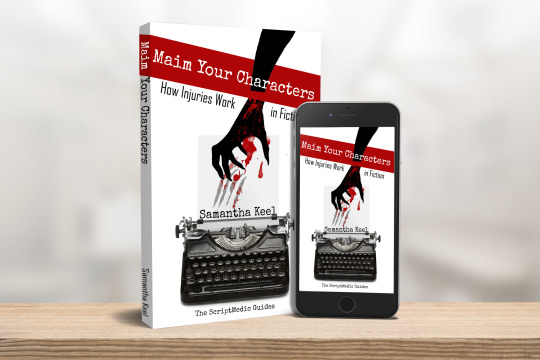#shawn is a character who fundamentally does not ‘Talk Normal’
Text
Content and Reality Genres

(This post is an excerpt from the upcoming Maim Your Characters)
What’s Your Content Genre?
Genres in fiction are the promises you make about the story you’re going to tell.
They’re a mutually shared set of expectations between you and your readers.
If you put a skull and crossbones on the front of your novel, there had better be pirates inside, preferably on the first page.
If there’s a spaceship, your readers would be very mad to find their story set entirely in a jungle in 1930s Congo and a distinct lack of aliens.
And iIf you put a cartoony cover of kids playing in a park on an erotica novel, monster is the kindest thing you will be called.
Genres tell readers what to expect. In an Adventure novel, we’re going to see great settings and a fast pace. In a Thriller we’re going to get violence, and at least one moment when the villain has the hero at their mercy.
We also don’t expect a bear-trap amputation injury in a Cozy Mystery or a Sweet Romance. But we do expect it in the Horror novel.
The point I’m trying to make is that your readers have expectations about what will or won’t happen in your novel, based on the genre you’re writing in. There are always methods available to push the limits, of course, but you can’t go wrong by sticking with what your reader expects – or at least by avoiding stepping too far out of the boundary lines.
A few suggestions…
Fantasy is typically fairly “clean,” in that we don’t see enormous gouts of blood or detailed descriptions of the gristle coming out of the wound. Wounds aren’t horrendous (unless you’re reading George R.R. Martin books). They also tend to be healed with magic rather than naturally, with truncated injury arcs.
Science Fiction likes fancy weapons like blasters and phasers, especially if you’re writing in Military Sci-Fi, but there may be some room for older-school wounds depending on who your hero is fighting. Also, I have never seen a car / scooter / spaceship crash producing significant injuries in a sci-fi story. Again, descriptions tend to be sparse and general; we see the man go down, but we aren’t invited to smell the burning flesh of the wound.
In Romance plots, I would stay away from significant injuries unless they happened prior to the start of the story. There are definitely stories in which nurses fall for their patients, and vice versa, and they’re not wholly made-up; if nurses never fell for their patients, I wouldn’t be alive, because my grandmother cared for my grandfather’s wounds in World War II.
In the softer subgenres of Mysteries, there tend to be murders but not injuries per se.
Action stories seem to think that anything from a bullet to the knee to a love tap with a pistol butt will knock someone unconscious (a trope I despise, by the way), but tend to be light on life-altering injuries. This is, in part, because a great many Action tales don’t have underlying emotional arcs. Think of Indiana Jones: He gets the treasure, loses the treasure, gets the treasure, loses the treasure, meets his ex, gets the girl again, gets the treasure. At no point does Indiana Jones fundamentally change.
Police Procedurals tend to focus on murders, but may be up for a good maiming, especially when an officer gets too close to an investigation and gets hurt. But it’s usually a beating that sidelines the character without a significant change in who they are or how they behave because of it.
The list could go on forever, but the point is this: understand the genre and subgenre you’re writing for so you know what your readers expect. Then deliver on those expectations, making sure that things actually matter.
It’s harder than it sounds, and more crucial than I could ever emphasize.
What’s Your Reality Genre?
There’s a phenomenal book on editing called The Story Grid by Shawn Coyne (and an absolutely epic podcast by the same name). It’s one of the most amazing writing books I’ve ever bought, and it’s worth every penny, and I’m going to borrow an element rather shamelessly from Shawn’s work.
Among other things, Shawn discusses what he calls the Five-Leaf Genre Clover, which is basically his way of categorizing stories. It’s based on structure, on content, and a few other things.
While there are obvious “genres” to do with story type and convention (horror, action/adventure, thriller, coming-of-age, etc.…), these fall under only under one leaf of the Clover, specifically the Content Genre leaf.
I want to talk about a different leaf: the Realism leaf.
Shawn breaks the Realism leaf of the Genre Clover down into four separate categories:
Factualism: These are stories based on things that have actually happened. An injury in a Factual story would be based on what happened and how a person coped. Biographies and historical tales fall into this genre.
Realism: Something that could plausibly happen in our real world. Injuries in the Realism genre need to be strictly accurate: the Inciting Injury is possible; the Treatment, plausible; the Recovery, realistic; the New Normal, what we would expect if it happened to our cousin.
Fantasy: This is Realism with added elements that are not possible in our reality. They can be elves, spaceships, or portable nuclear generators. Injuries in the Fantasy setting can be totally realistic (if the fantastical elements have nothing to do with healing technology or magic). Remember what Arthur C. Clarke said: Sufficiently advanced technology is indistinguishable from magic. Science Fiction is a kind of fantasy in which the fantastical elements are based on real or theorized science, though different subgenres incorporate different levels of realism.
Absurdism: This is a type of world in which an Injury might be treated by filling the character with marshmallows and rolling them up a hill, or a fish might tell your character that to err is divine but to drive to New Mexico is human. Absurdist stories aren’t bound at all by Realistic logic, or at least break that logic deliberately.
Here’s the thing: You need to know which genre you’re writing in. Can you get away with hand-wavy magical healing in your genre? If you’re writing a gritty Realistic war story, probably not. If you’re writing a soft sci-fi (Fantasy) book, probably so. But what about stories in the middle?
For example, if you’re writing an Absurdist piece, go with your imagination: Why shouldn’t the poisonous snake spit healing medfoam that gives your character acid trips but heals their wounds?
Factualism is simply a subset of Realism: it’s based in the real world, and also bounded by history and actual events that took place. The rules of Realism and the rules of Factualism are going to be essentially the same, from this perspective, so we can just roll them into one.
So that leaves us with two functional reality genres left to work in: Realism and Fantasy. We’re going to discuss each of them in detail in the next chapter.

This post is an excerpt from the forthcoming Maim Your Characters, out September 4th, 2017 from Even Keel Press. If you'd like to read a 100-page sample of the book, click here. If you'd like to preorder signed print or digital copies of the book before 9/4/2017, or claim Executive Producer status of the upcoming Blood on the Page, click here.
xoxo, Aunt Scripty
This post appeared first on Patreon! Would you like to see the future?
235 notes
·
View notes